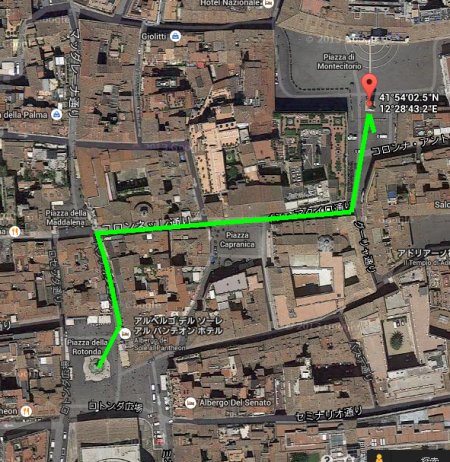
to Piazza di Montecitorio (right)
|
| |
 to Piazza di Montecitorio (right) |
Montecitorio Obelisk
| Present Site: | Piazza di Montecitorio, Rome (In front of Palazzo Montecitorio) N 41°54'2.5"(41.900695) E 12°28'43.2"(12.478667) |
| Pharaoh: | Psamtik II (Psammetikos II, Reigned early 6th Century BC) |
| Measurement: | 21.79 meters high for obelisk itself 33.27 meters high with the pedestal and the top globe |
| Weight: | Estimated 214 tons |
| Stone: | Red granite |
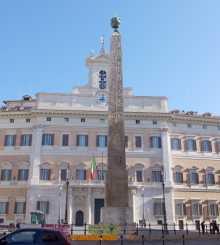
Montecitorio Obelisk
The building behind the obelisk is Montecitorio palace. |
About The Site:
The site of obelisk, Piazza di Montecitorio is in front of Palazzo Montecitorio.
The Palazzo (Palace) was built in late 17th century, and is used for the Italian Chamber of Deputies (lower house) since 1871. This building was designed by Giovanni (Gian) Lorenzo Bernini [1598-1680] who made the Fountain of the Four Rivers (Fontana dei Quattro Fiumi) of Piazza Navona, and the elephant statue for the base of Minerva Obelisk.
Bernini is the leading sculptor and architect in baroque period, ans he and the obelisk have deep relations as he made St. Peter's Square (Piazza San Pietro) in Vatican City, and the church of Sant'Andrea al Quirinale in Piazza del Quirinale.
According to movie "Angels & Demons" (based on Dan Brown's novel of the same name), Bernini is a member of Illuminati, and the obelisk is said the relation to Illuminati. This may be derived from such unity of Bernini and the obelisk. Since those locations are important points which are asked Bernini for the design, the obelisks might have been actually erected, I assume.
How To Get There:
Although Barberini Station and Spagna Stations on Metro Line "A" are the nearest stations, but we must walk about 600 meters from the stations. If we take Bus #175 (for Partigiani), and get off at Corso-Minghetti, it's about 200 meters by walk.
The Piazza di Montecitorio is also about 250 meters from Piazza della Rotonda, in front of Pantheon. As shown the aerial photo at right, go north through an alley right side of a small cafe of north of Piazza della Rotonda, then proceed east on narrow street Via delle Colonnelle, then we'll reach at the south end of the Piazza. Please follow the green line on the aerial photo.
About The Obelisk:
This obelisk was originally erected by Psammetikos II (Psammetico II), the Pharaoh of Third Intermediate Period of Egypt, 26th Dynasty. He is a father of the Pharaoh Wahibre (Apries in Ancient Greek) who erected Minerva Obelisk and Urbino Obelisk. Psammetikos II reigned for only 6 years, 595-589 BC, hence the erected year of this obelisk is specified for a limited time period.
Octavianus (the first Roman Emperor Augustus,reigned 27 BC - 14 AD) who conquered Egypt in 31 BC, was attracted by the Egyptian obelisk, and then he carried out two (a pair of) obelisks to Rome in 10 BC. One is this obelisk, another one is the Flaminian Obelisk at the Piazza del Popolo in Rome.
These two obelisks are the first ones which will be carried into Rome since then.
The Sundial: After carrying into Rome, this one was erected as the hand (or gnomon) of a huge sundial. Hence, this sundial is also known as "Augustus Sundial". For this reason, this one is also called Solare obelisk which means solar (sun) obelisk.
The sundial (or obelisk) was in the Campus Martius (Campo Marzio) of Ancient Rome. That location is estimated about 200-meter northwest of current obelisk site, Piazza di Montecitorio.

The Augustus Sundial had once stood at the location of the left building, facing the Piazza del Parlamento. This picture was taken from south-west of the Piazza. (May 3, 2016) |
The Augustus Sundial seemed to remain until 8th century (or other source says, 10th or 11th century). It was buried underground and forgotten. Then the obelisk was discovered in 1512, however it was left for more than 200 years due to probably a difficult restoration.
In 18th century, then Pope Pius VI [reigned 1775-1799] repaired it and added the bronze globe decoration with the emblem of Pius VI on top, and re-erected in 1792 at the current location, Piazza di Montecitorio.
According to Mr. Andrea Pollett's website Virtual Roma, a hole was made on the globe, a ray of sun light was supposed to cross the globe, marking the date on the square's pavement. But the new device proved inaccurate and very soon became useless.
On the south side, although the lower damaged portion is restored, the hieroglyph still remains in quite fine condition. The horus name of Psammetikos II and coronation name, birth name with cartouche can be clearly readable, although the descriptive method is slight different from the obelisk of new kingdom era. The inscription both side is well considered the symmetric arrangement, and shows us the stylistic beauty.
On the other hand, no inscription is on north side, only a part of inscription remains on east and west sides. This means, the inscription barely kept only on the south side, and other two-third portions were restored. I imagine that the restoration work would be very time-consuming, as it must be quite difficult to provide the stone materials for meeting the irregular surface of the damaged original obelisk.
The Measurements: The current status is 21.79 meters high (*1) for obelisk itself, and 33.27 meters (*2) with thr pedestal and the top globe though, the original obelisk must be longer than now, because the lower portion is missing. It weights about 214 tons. (*3)
(*1) The Complete Temples of Ancient Egypt, Richard H. Wilkinson; The Obelisks of Egypt, Labib Habachi
(*2) Website "Roman Monographs", Andrea Pollett
(*3) Cleopatra's Needles and Other Egyptian Obelisks, E.A. Eallis Budge
Notes For Pictures:
Since the Palazzo Montecitorio is the seat of the Italian Chamber of Deputies, some 10 policemen and several police cars are always deployed for the security reason. When I visited here in summer 2013, the protesters were sitting in this Piazza, and the lower portion of the obelisk was hided by the large banners. So, I took pictures again in Summer 2014, which are posted below. Some banners still can be seen at the base.
Not so many tourists come here because here is out of the major tourist routes of Rome.
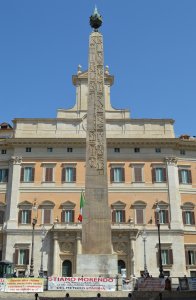
South Side |
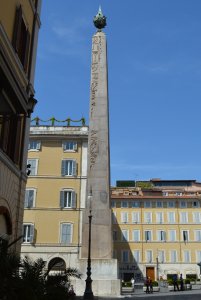 East Side |
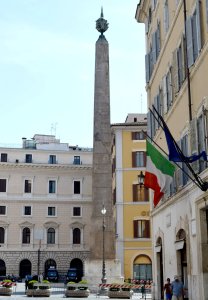 West Side |
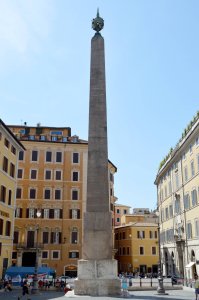 North Side |
|||
August 11, 2014 by Hiroyuki Nagase (For high definition image, please click the picture) | ||||||
Copyright Hiroyuki Nagase nagase@obelisks.org and Shoji Okamoto okamoto@obelisks.org